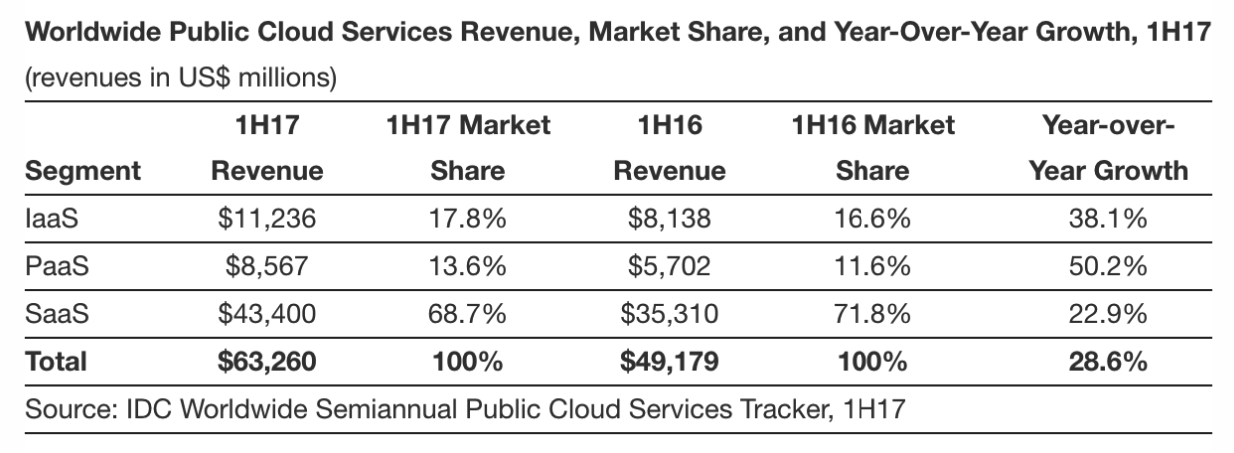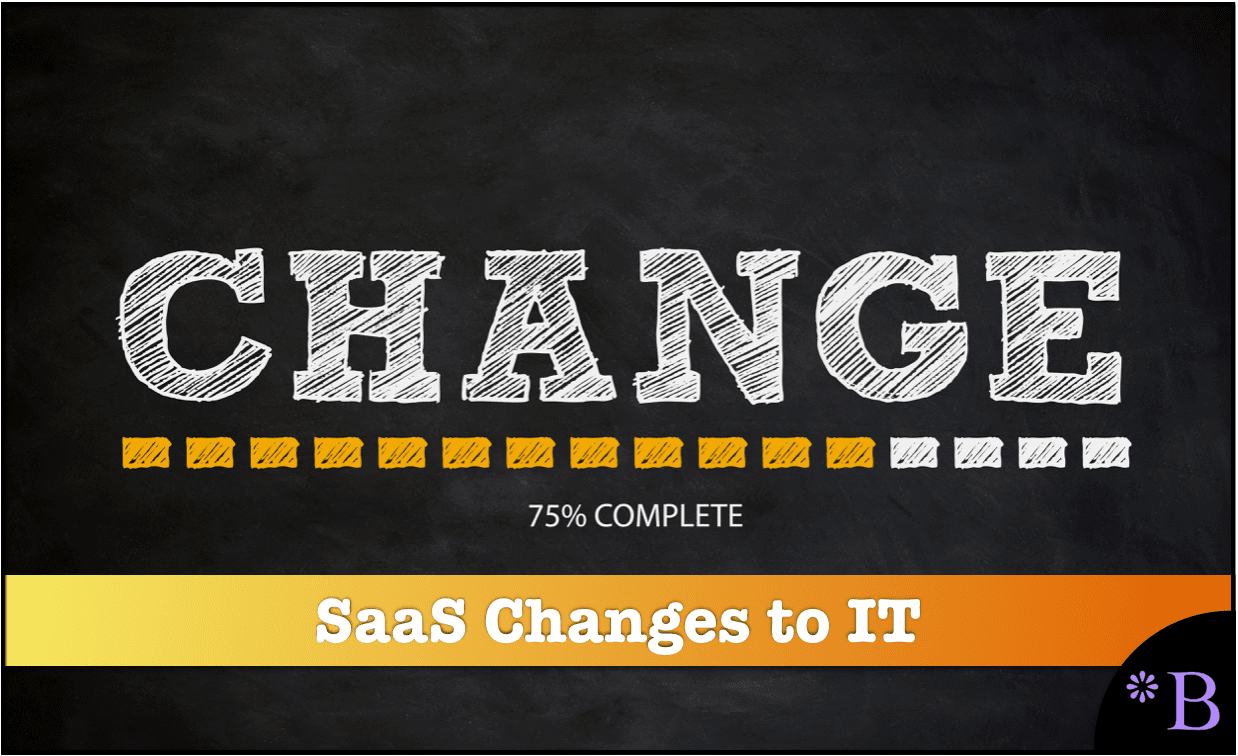How to Understand Where Cloud is Going in the Future
Executive Summary
- Cloud is vital to many areas of IT and can bring significant productivity improvements.
- We cover some of the important developments in this field.

Introduction
Web services are segmented into SaaS, PaaS, and IaaS. In this article, we will cover their history and where they are headed.
Our References for This Article
If you want to see our references for this article and related Brightwork articles, see this link.
The Switch in Growth from SaaS to IaaS
IaaS and PaaS were not the first types of remote delivery to become popular. The first was SaaS, which is where a vendor sold access to a centralized multi-tenant web-based application.

AWS’s explanation of SaaS. SaaS was thought to change the enterprise software space dramatically, but this has not yet happened. It is now IaaS/PaaS that is growing more rapidly and reconfiguring enterprise software while starting significantly later. No SaaS vendor has ever matched the growth that AWS has experienced. Although AWS also provides SaaS services, most of its services are PaaS or IaaS.
SaaS Begins the Cloud Process but Gives Way to IaaS Prominence
While beginning with great fanfare and receiving large amounts of venture capital funding, SaaS vendors have proven to have grown slowly overall, and profits are hard to come by. The largest SaaS vendor, Salesforce, has seen its growth slow, and it now behaves more like an on-premises vendor in many respects than a SaaS vendor with its restrictive terms and conditions. (recall that being cloud has specific requirements and can’t be self-ascribed) Moreover, the overall cloud nature of applications is overstated because of companies like SAP and Oracle. Their organizational structures are set up for on-premises development, sale, and delivery that cloud wash and try to trick customers and Wall Street as to how much progress they are making moving to the cloud.
What Area of Cloud is Growing Fastest?
SaaS applications certainly have many advantages. And for consumers who access Gmail or a SaaS invoicing application or use Google Docs as examples, it has allowed users to access many applications quickly and easily. However, PaaS/IaaS will ultimately prove to be far more transformational for enterprise customers than will SaaS. Furthermore, PaaS/IaaS is growing far more rapidly than SaaS vendors combined. This is illustrated in the measurement of each service category, but don’t zero in on this graphic too strongly, as we are about to critique its accuracy.

Some of the growth in SaaS is not actually growth. For instance, major vendors like Adobe and Microsoft transitioned their on-premises revenues to SaaS revenues. That is, it has merely replaced on-premises software revenues. Therefore even the 22.9% growth in SaaS is not entirely “growth.” Once that is taken into account, IaaS and PaaS growth looks even more impressive. Some of this is also conversion as more IaaS growth means fewer servers being purchased and ultimately less IT employment in companies that use IaaS services. Thus part of this is a redirection of revenues. The PaaS revenue is more distributed among different providers, while AWS has a huge chunk of the overall IaaS revenues. We include this graphic from IDC, but the estimates from different firms on this topic are all over the place. Vendors are cloud washing like crazy, so anyone performing this analysis needs to adjust for that factor, or the numbers won’t be accurate.
The Cloud Revenue Estimates
Gartner proposes the following numbers for 2017 (in millions).
- Cloud Business Process Services (BPaaS) $40,812
- Cloud Application Infrastructure Services (Pass) $7,169
- Cloud Application Services (SaaS) $38,567
- Cloud Management and Security Services $7,150
- Cloud System Infrastructure Services (IaaS) $25,290
- Cloud Advertising $90,257
- Total Market $209,244
If we compare just IaaS, IDC comes to $11,236 million versus $25,290 million. That is a pretty significant discrepancy. And there is another problem. Both IDC and Gartner are so commercial, and profit maximized, we don’t find either firm’s reports on this or other topics compelling.
- The book by one of the authors, Shaun Snapp on Gartner, found that they follow no established research conventions and market services to vendors by telling them that they will perform better in various Gartner products by purchasing advisory services. Gartner has a poor record in forecasting, and their forecasts seem to be more focused on garnering attention than on being accurate.
- IDC is part of IDG, which publishes eight of the largest IT media publications (ComputerWorld, CIO, and others). As we covered in the article How IDG Works to Provide Inaccurate Information, their financial bias is deep, and their accuracy is extremely low.

The Major IT Changes Due to SaaS
There is a lot of coverage on the growth of SaaS and a lot of coverage of SaaS from the sales and marketing perspective.
Two people I have read and corresponded with on this topic who have an excellent understanding of these changes are the following:
- Kenny Fraser: Who focuses on sales changes driven by SaaS and…
- Anne Janzer: Who focuses on subscription services, how they work, and their marketing. These are two people/authors who get what is coming with SaaS.
However, SaaS has many implications that are also not covered, and SaaS seems quite likely to impact everything from IT workers, outsourcing, the value delivered by applications, to market competition, to application integration.
Why SaaS is So Important to So Many Areas of IT
SaaS is a model that must be considered one of the most important historical changes in software delivery impacts many areas.
In my view, SaaS is the introduction of high-capacity machinery in agriculture or manufacturing.
Major Productivity Changes with Saas

Some things come along that completely change the economics of what is being done. Harvesting grain this way is super-efficient. Imagine that at one-time, grain was harvested by hand.
That is, the change is significant enough to change the efficiency of how work is done in the area. And this has happened many times in the history of production. And the before and after “pictures” are often unrecognizable. Sometimes those things happen right before our eyes.
Something similar is happening in the delivery of enterprise software. It has been underway for some time, but its actual impact is not yet felt because so much on-premises software still exists.
SaaS Areas of Change
There are so many areas to cover on SaaS. However, if we stay focused on labor for a moment, some engaging projections can be made.
- The Decline of IT Consulting Numbers: There is no way that all IT consultants currently working in the US will be necessary when SaaS rules the land.
- Migration in Employment: Due to efficiency gains, fewer IT employees will be needed, but there will be somewhat increased employment at both software vendors and infrastructure providers — such as Amazon Web Services.
- Monopoly Power in Enterprise Software: The on-premises model protected many software vendors that had substantial monopoly power. I won’t mention them by name because people tend to get their feelings hurt when they are told they work for a monopolist company, but the companies should be fairly obvious to the casual observer. This monopoly power declines when subscription-based software becomes the predominant form of software delivery, and their share of the enterprise software market should drop. These vendors have more SaaS applications, but they will not have the advantages they did previously.
- Software Sales and Presales: In the on-premises software model, sales and presales serve as guides through the software. The process is lengthy for both sides, and the presentation and experience of the software are controlled. SaaS software is entirely different. SaaS vendors put much less money into sales and expect their prospects to find out much of the information they need to make a purchase decision from the internet and free trials. SaaS vendors follow up and are there to answer questions at any time. SaaS software sales become service selling, which is very different than product selling — which is what on-premises selling is. I cover this in SaaS’s Effect on Sales and Software Selection.
- Integration Becomes More of a Commodity: SaaS vendors have shown a much higher propensity to integrate with other vendors. Salesforce.com is the shining example, making adding a vendor within their force.com about as easy as it can be. Salesforce is a bit of an exception as they have the largest SaaS marketplace in existence. But the statement does generalize that SaaS vendors are much easier to integrate than on-premises solutions. However, this means, again, less consulting work in writing custom interfaces.
- IT Outsourcing has Reduced: IT outsourcing is a form of low-quality cost-cutting with no technological advantage over in-house provided IT support. SaaS completely alters the incentives and reasoning behind outsourcing. I cover this topic in the article The Effect of SaaS on IT Outsourcing.
Using a No Server Policy and Going 100% SaaS
I end up interviewing and speaking with a lot of people that start-up software companies. Recently I came upon an interesting viewpoint related to the necessity to own one’s own IT infrastructure. Most companies believe that you do need to have your own servers.
When we started our company, one of the first things we put in place was a formal, no-server policy. We will not buy servers for any reason. Even product development is done in the cloud. – Vaidya Iyer, AppsFreedom
Vaidya is on to something here. Maintaining your servers is only becoming less necessary as every year, the SaaS options expand.
Conclusion
The problem is that there are not many entities that track these numbers. However, as we covered in the article The 23 Largest Software Vendors in the World, the largest vendors are not primarily SaaS vendors. There is a discrepancy between SaaS coverage and the actual percentage of revenues that true SaaS drives.